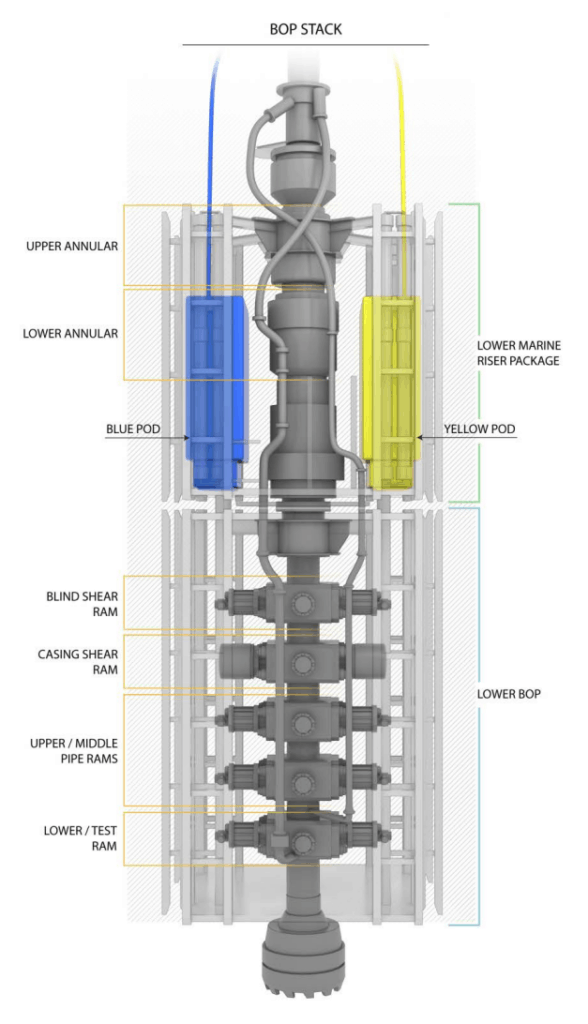If the drilling column fluid barrier and the cement barrier both fail, and the well is still open (no plug installed), as was the condition with the Macondo well, drilling crews depend on a blowout preventer (BOP) to control pore pressures. The drilling crew can manually operate the BOP to control or regain control of the well during an initial kick by closing one or more BOPs. Most importantly for the Macondo well, the BOP stack was an emergency response mitigation device with both manual and automatic functions meant to shear drillpipe, seal the wellbore, and disconnect the rig from the well.
Deepwater Horizon BOP Stack

Like many subsea BOPs, the Deepwater Horizon’s BOP was a massive stack of multiple preventers. The BOP was nearly 57 ft tall and weighed approximately 400 tons. The BOP was anchored to the top of the well casing at the seabed and was connected to the Deepwater Horizon by a riser. Drilling equipment, drillpipe, tubulars, and other tools used in the drilling process could be lowered from the rig, through the riser, through the blowout preventer, and into the Macondo well.1U.S. Chemical Safety and Hazard investigation Board. (2014, June 5). Investigation Report Volume 1: Explosion and fire at the Macondo Well. https://www.csb.gov/file.aspx?DocumentId=5930
The Deepwater Horizon’s BOP was built by Cameron and had been used on the Deepwater Horizon since the rig began its service in 2001.
The Crew Attempts to Close Annular and Pipe Rams
When drilling mud and hydrocarbons began pouring out of the well and onto the Deepwater Horizon, the drilling crew activated a component called an annular preventer, which should have sealed the space around the drillpipe and prevented further hydrocarbons from rising above the BOP. However, well data indicate that this component failed to seal the well. Not only did the riser fluids—the hydrocarbons, drilling mud and seawater—that already passed above the BOP continue to travel up the riser and release onto the rig floor, but the riser was also being replenished by the flow of even more hydrocarbons through the leaking component.2U.S. Chemical Safety and Hazard investigation Board. (2014, June 5). Investigation Report Volume 1: Explosion and fire at the Macondo Well. https://www.csb.gov/file.aspx?DocumentId=5930
Pressure data indicate that the crew closed at least one additional sealing component of the BOP—the pipe ram, which successfully shut in the well but caused the pressure in the drillpipe to build substantially. Riser fluids above the BOP continued to unload onto the rig floor, but their replenishment temporarily ceased. About two minutes later, the first explosions occurred on the rig and data transmission from the rig to
shore ceased.3U.S. Chemical Safety and Hazard investigation Board. (2014, June 5). Investigation Report Volume 1: Explosion and fire at the Macondo Well. https://www.csb.gov/file.aspx?DocumentId=5930
Emergency Disconnect System and Automatic Mode Function/Deadman
In the minutes following the explosion, a crew member pressed the Emergency Disconnect System (EDS) button on the bridge BOP remote control panel. This maneuver should have activated the BOP components that would shear the drillpipe, seal the well, and disconnect the rig and riser from the BOP, thus allowing the Deepwater Horizon to move away from the wellhead. However, there was no indication of EDS actuation which was likely a result of the explosion damaging the rig-based BOP control systems and power and communication lines between the rig and the BOP.4U.S. Chemical Safety and Hazard investigation Board. (2014, June 5). Investigation Report Volume 1: Explosion and fire at the Macondo Well. https://www.csb.gov/file.aspx?DocumentId=5930
The BOP emergency shut-in systems were not fully operable prior to the incident. Despite failures to multiple redundant systems, the Automatic Mode Function (AMF)/deadman activated when communications, electric power and hydraulic power were severed between the Deepwater Horizon and the BOP immediately following the explosions and fire on the rig. This system was meant to shear the drillpipe and seal the well, but as evident from the major oil spill that ensued, the well remained unsealed.5U.S. Chemical Safety and Hazard investigation Board. (2014, June 5). Investigation Report Volume 1: Explosion and fire at the Macondo Well. https://www.csb.gov/file.aspx?DocumentId=5930
Image Credits
- Macondo-BOP-stack: U.S. Chemical Safety and Hazard Investigation Board